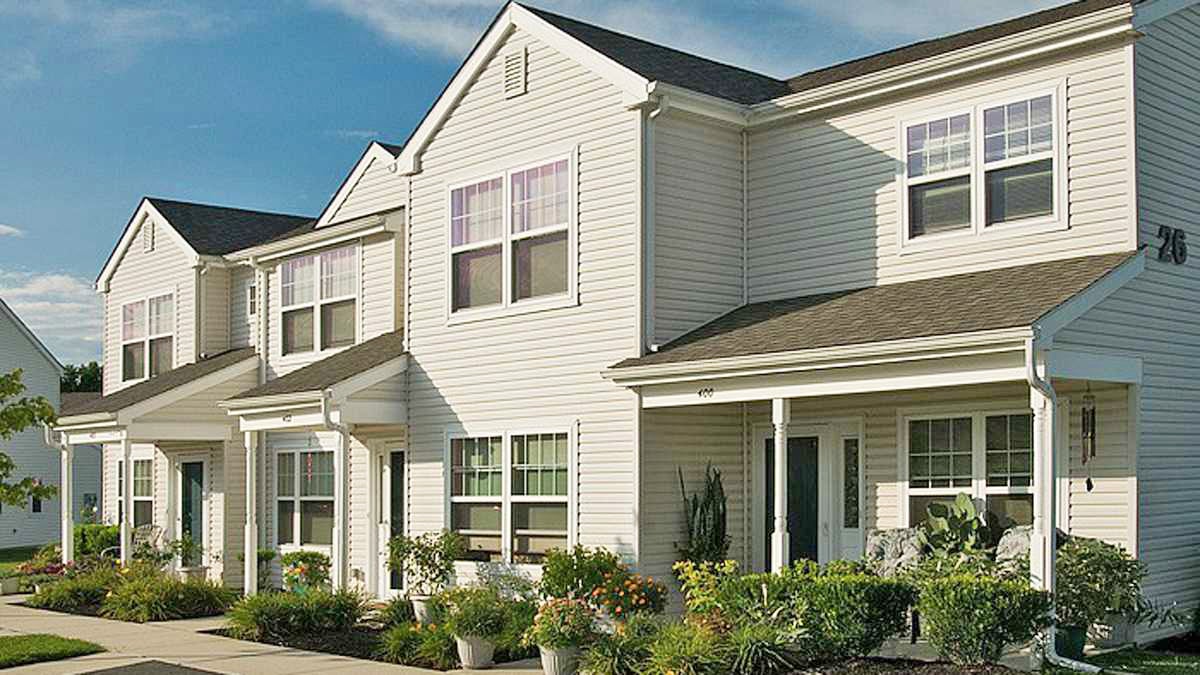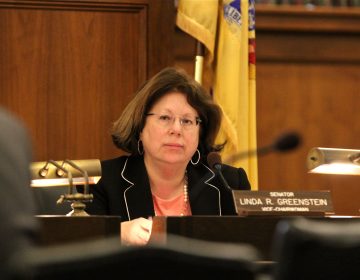New Jersey Supreme Court being asked to kickstart low-income housing quotas

The Ethel R. Lawrence Homes was the first affordable housing complex built in the suburbs under the Mt. Laurel Doctrine. (Mark Lozier/Fair Share Housing Development)
With varying degrees of frustration, New Jersey’s Supreme Court justices on Tuesday peppered attorneys with questions for more than three hours about the best way to restart the construction of affordable housing in the state, most likely without the body currently charged with the job.
The state’s highest court spent more than three hours considering a motion by Fair Share Housing Center to give the authority ensuring that municipalities develop low- and moderate-income housing back to the courts, where it had resided in the 1980s, prior to the state law that created the Council on Affordable Housing.
“Dysfunctional,” “moribund,” and “closed for business” were some of the terms used to describe the council, which did not adopt new housing rules last October, as ordered by the Supreme Court.
Even Geraldine Callahan, the deputy attorney general representing the state, could not say that COAH might ever meet again to consider the rules.
“At this time, there is no meeting noticed,” she said, in response to justices’ questions about whether the council might try again to adopt or amend the rules on which it deadlocked 3-3. “I cannot speculate on the council’s future actions.”
Credit: Chris Pedota/The Record (Bergen County NJ)/POOL
Geraldine Callahan addresses the justices, representing the Council on Affordable Housing.
Callahan argued that the court should not kick responsibility for affordable housing construction back to the courts because COAH at least tried to do all it was ordered to do last March — it met, proposed rules, held a hearing, and met to adopt the rules. But its six sitting members could not agree either to adopt the rules or amend them and adopt them at a later time.
“Your argument smacks a little bit of, ‘Well, we hit all of our marks, what more do you want from us?’“ said Judge Mary Catherine Cuff, an appellate division judge who is filling a vacancy on the court. “Our order was to yield a result.”
She and Justice Jaynee LaVecchia both noted several times that last month, when it scheduled its hearing on this matter, the Supreme Court had stated that COAH was free to continue to try to come to an agreement on rules. But Callahan acknowledged that the council has not met since last October.
“Can you assume it (COAH) intends to do nothing?” asked Justice Barry Albin. “How many more years do you want us to wait until we enforce our orders? … COAH has apparently put a sign on its door saying, ‘Closed for business.’“
Kevin Walsh, who argued for Fair Share, agreed that COAH has sent a clear message that “it’s game over.” After waiting 15 years for valid third-round rules, Walsh said it is time for the court to act to ensure that New Jerseyans will be able to afford to live in decent housing throughout the state, as it declared they should in its two prior Mount Laurel rulings.
The Supreme Court broke controversial ground four decades ago when it first ordered, in an exclusionary zoning case involving Mount Laurel Township, that municipalities have a constitutional obligation to meet their “fair share” of the need for affordable housing in regions of the state.
What is the Mount Laurel Doctrine?
In 1983, the court further qualified its ruling, setting up special Mount Laurel courts throughout the states and giving judges the authority to impose a “builders’ remedy” that typically allowed for the construction of four market-rate units for every affordable one in municipalities found to be practicing exclusionary zoning.
Unhappy municipal officials helped convince the Legislature to pass the Fair Housing Act, which created COAH to determine municipal housing obligations and prevented municipalities agreeing to follow the COAH rules from being sued.
But the council’s inaction and disregard for court orders means that today “the Mount Laurel doctrine exists, but in name only,” Walsh said. The last 15 years without housing rules in place has had “real human consequences, so we come to this court to ask you to do what you promised.”
Credit: Chris Pedota/The Record (Bergen County NJ)/POOL
Associate Justice Mary Catherine Cuff questions Kevin Walsh, representing Fair Share Housing.
Walsh said that returning jurisdiction over affordable housing to the courts would “not need to recreate the wheel” but could follow the same path used in the past that worked well.
Arguing to essentially render COAH meaningless is the opposite of one fight Fair Share has been waging since Gov. Chris Christie was elected and attempted, as one of his first actions, to abolish the agency. Fair Share was successful in getting the Supreme Court to prevent Christie from getting rid of the agency and in September 2013 got the court to order COAH to adopt new rules by last February. When the council missed that deadline and sought more time, the court gave it more time, but that was the October deadline COAH missed.
At the meeting where it was to have approved its rules, three COAH members said what was proposed would not have met the court’s order to adopt rules substantially similar to those used in its second round, which expired in 1999, and refused to vote for them, urging instead that they be amended and adopted at a later date. The other three members, including two Christie appointees and the president of the New Jersey State League of Municipalities, said not the adopt the rules at that date would violate the court order and so voted for the rules.
Credit: Chris Pedota/The Record (Bergen County NJ)/POOL
Associate Justices (from left) Lee Solomon, Anne Patterson, and Jaynee LaVecchia.
The only justice who seemed to want to give COAH the benefit of the doubt was Justice Anne Patterson, who asked numerous questions of all seven attorneys who argued. Patterson had dissented from the court’s September 2013 ruling that invalidated the council’s prior stab at adopting third-round rules. That so-called growth-share system had sought to base municipal housing requirements on future growth, not actual current need. The majority of the court, led by LaVecchia, found that rule unconstitutional.
Still, attorneys representing municipalities urged the court to give COAH another chance.
“The court should order COAH to meet, and have task force meetings in between monthly meetings, and provide period reports as to how it is trying to break the deadlock,” said Jeffrey Surenian, representing Atlantic Highlands.
“We are 15 years out, how much longer do you want us to wait?” Albin asked. “How much longer do you want poor people to wait? … We have issued orders. What do we do now, say, ‘Remember that order we issued nine months ago? We’re going to issue another one.’“
“If we had something in front of us, some reasonable likelihood that COAH would act, it would be different,” said Lee Solomon, the state’s newest justice, a former GOP legislator nominated last year by Christie. “We don’t have any.”
“You should not allow this state agency yet another chance to show utter disregard for this court,” urged Walsh.
But Surenian said, “Municipalities should not be responsible for COAH’s failure.”
At that time, and again yesterday, justices also said the Legislature can act to change the Fair Housing Act if it wishes. But given that lawmakers have tried — only to have their legislation vetoed by Christie — this is unlikely to occur soon.
Much of the questioning during the hearing — slated for an estimated hour and 50 minutes but stretching for about 3 hours and 20 minutes, into the justices’ lunch hour — centered on how a COAH-less system of affordable housing rules should operate.
“How do we establish standards without COAH having acted?” LaVecchia asked.
Walsh said there are already six housing regions recognized for the state. Judges in each of those could use data Fair Share provided to COAH to calculate the housing need.
“We know how to do this,” he said. “We have done this very well.”
But three attorneys representing municipalities could not have disagreed more.
“It’s a mess,” Surenian said, adding he has worked with a town that has spent $600,000 defending against a builder’s remedy lawsuit. “You don’t want to go down that road. Anyone who suggests otherwise is inaccurate.”
Albin asked for an estimate of how many affordable units have not been built over the past 15 years due to “the failure of COAH,” saying this information is important since the court is “being asked to do something rather extraordinary.”
Walsh said that about 60,000 homes were built between 1987 and 1999 as a result of the first two COAH rounds. Adam Gordon, another Fair Share attorney, said municipalities had proposed nearly 43,000 homes in their plans submitted to COAH in 2008 and in most cases those were not built due to the lack of rules in place. But it’s a conservative estimate.
Credit: Chris Pedota/The Record (Bergen County NJ)/POOL
Associate Justices Barry Albin (left) and Faustino Fernandez-Vina confer while on the bench.
There are 314 municipalities that submitted affordable housing plans to COAH under the rules deemed unconstitutional. For the most part, they have not proceeded with construction plans due to the uncertainty of what they would be required to build.
The rules COAH proposed last spring on which the council deadlocked had called for the construction of about 53,000 new affordable units statewide, more than half of which should have been built as long ago as 1987, and the refurbishing of some 63,000 existing units. Housing advocates had argued those rules were flawed and would not have passed constitutional muster.
Edward Buzak, representing the New Jersey State League of Municipalities, said it would be preferable for the court to work with the rules COAH had tried to propose, perhaps by appointing a disinterested third party to go through those rules and the 3,000 comments made about them and come up with a plan.
“You cannot and should not jettison that administrative process,” he said.
LaVecchia said it would be an “unprecedented act … disrespectful to the legislative branch” to “pick some new person to establish the housing policy of the state.”
Several times, justices and attorneys asked what actions the court can take given the separation of powers among the three branches of government.
“Does this court have the authority to order the release of the proposed new third-round rules?” asked Solomon.
Credit: Chris Pedota/The Record (Bergen County NJ)/POOL
Stephen Eisdorfer, representing the NJ Builders Association.
“What this court has taught us, has said in school funding and redistricting cases, is that it can exercise whatever powers it needs to exercise, extraordinary powers,” Eisdorfer said, referring to other landmark rulings the court has made.
Patterson said she could find no precedent in law about what the court should do if a rulemaking agency deadlocks, as COAH did.
“I think we are in new territory,” she said, adding that lawmakers must have contemplated this might happen given they constituted COAH as a body with an even number of members — statutorily 12 — of diverse backgrounds. The council currently has only six members, since Christie has declined to fill all the slots, some of which would have to go to builders, who would likely support rules that would lead to home construction.
Two attorneys representing builders supported Fair Share’s motion in court.
Stephen Eisdorfer, representing the New Jersey Builders Association, offered proof that low- and moderate-income people have suffered over the last 15 years of inaction. He said that the percentage of low-income residents forced to spend more than 30 percent of income on housing rose from 68 percent to 83 percent during that time, while for those of moderate income, now 60 percent must pay more than 30 percent of income for housing, twice as many as 15 years ago.
“Poor people have suffered dramatic harm,” he said. “They have been punished.”
Patterson said the Fair Housing Act specifically gave immunity from lawsuits to towns that followed COAH’s rules and asked what should happen to the 314 municipalities that tried to do so and expected to be free from litigation. Wouldn’t opening up towns to suits lead to higher costs for towns in financial straits and would it lead to more sprawl?
“I don’t think requiring towns to comply with the constitution is punitive,” Eisdorfer said. “We have lots of experience with the builder’s remedy, thirty-odd years experience. Towns learned to cope. No, they don’t like it. No, I don’t think there’s any evidence that builder’s remedy litigation has been financially draining. Has it caused sprawl? … It’s compact development; it replaces large lot development. Inclusionary zoning is anti-sprawl.”
“It would be much better, more streamlined, less expensive, if COAH was doing the job it was supposed to do,” said Jonathan Drill, who represented four municipalities, including Bernards Township, “but I’m a realist … Give municipalities basically a soft landing. Let us have temporary immunity (from lawsuits) so we can properly plan.”
Walsh argued for only a brief immunity, perhaps 60 days, to allow municipalities to get their plans in order, because allowing for indefinite immunity from lawsuits will only lead to inaction and no affordable housing being constructed.
“We have set forth in our brief a remedy that gets the Mount Laurel doctrine up and running again, and respects the dignity of this court,” he said.
When the court might rule is unclear, although there were indications yesterday and in its prior recent rulings that a majority of justices consider this a pressing issue. Buzak suggested that since only six members of the court were present — Chief Justice Stuart Rabner recused himself, as he did in the September 2013 decision on the housing rules — it’s possible that the court itself might deadlock.
That might seem likely looking at the political affiliations of the members, but the justices’ questions and comments seemed to indicate a majority willing to take some action to move the process forward.
__________________________________________
NJ Spotlight, an independent online news service on issues critical to New Jersey, makes its in-depth reporting available to NewsWorks.
WHYY is your source for fact-based, in-depth journalism and information. As a nonprofit organization, we rely on financial support from readers like you. Please give today.




